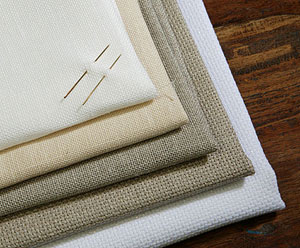Calculating How Much Cross Stitch Fabric To Buy
When calculating how much cross stitch fabric you need to buy you will need a piece of fabric large enough to accommodate your cross stitched design. There should also be enough spare fabric all around the edges to allow at least 2 inches (5 cm) for folding or turning when the embroidery is framed or made up.
To calculate how much cross stitch fabric will be needed, first count the number of squares horizontally and vertically on your cross stitch design. Next, divide the number of squares by the number of cross stitches produced per inch (2.5 cm) of your chosen fabric.
For example:
Your design has 110 squares and 99 squares.
Your chosen fabric is 11 count Aida – so you will get 11 cross stitches to 1 inch (2.5 cm).
110 divided by 11 (110/11) = 10
99 divided by11 (99/11) = 9
Your finished embroidery will measure 10 x 9 inches (25.5 x 23 cm) and to this you need to add a turning allowance of 2 inches (5 cm) all around. Therefore, the piece of fabric you need to cut should measure 14 x 13 inches (35.5 x 33 cm).
Remember to divide the thread count of an evenweave fabric by two to determine the number of cross stitches per 1 inch (2.5 cm). For example, a 28 count evenweave fabric will produce 14 cross stitches per 1 inch (2.5 cm).
To check whether your embroidery will fit a chosen mount, for example, when creating a greeting card, calculate the finished size of the embroidery as described above. if too large to fit the mount, work on a finer fabric with a higher count. If too small, work on a coarser fabric with a lower count.
How Much Cross Stitch Fabric : Fabric Allowance
It is essential when working out how much cross stitch fabric you require to allow enough fabric surrounding the design area for stretching and framing. As a general rule, 4 – 6 inches (10 – 15 cm) will be sufficient, although smaller pieces such as brooches, miniatures and cards will not require this much excess fabric.
You should always measure your fabric carefully and cut along a thread line using sharp dressmaking scissors. There are a number of methods you can use to prevent the cloth from fraying – over sew the edges by hand, machine sew the edges using a zig-zag stitch, secure the edges with sticking tape (using masking tape is not recommended as it can pull threads when being removed and also leave a sticky residue which attracts dirt) or use a commercially made liquid material which is applied to the edges of the fabric.
Recommended Reading
Looking for a good book to read? If your looking for a great reference book to help you out with answers to your cross stitching questions, or maybe your just looking for a present to give that loved one who is mad about cross stitch. Then head over to our books page where we have compiled a list of great books that no serious cross stitcher should be without.
Related Terms:
How Much Cross Stitch Fabric
Learn more about…
- How to Cross Stitch – General Guidelines
- Cross Stitch Fabrics
- Cross Stitch Thread or Floss
- Calculating How Much Cross Stitch Fabric To Buy
- Cross Stitch Needles
- Cross Stitch Frames and Hoops
- Cross Stitch Charts
- Cross Stitch for Beginners: Securing the edges, finding the centre of the fabric and preparing the thread
- Starting and Finishing a Cross Stitch Pattern
- Working Hem stitch
- Scoring and Stitching a Folded Hem
- Washing and Ironing Cross Stitch
- Stretching and Mounting Cross Stitch
- Framing Cross Stitch

